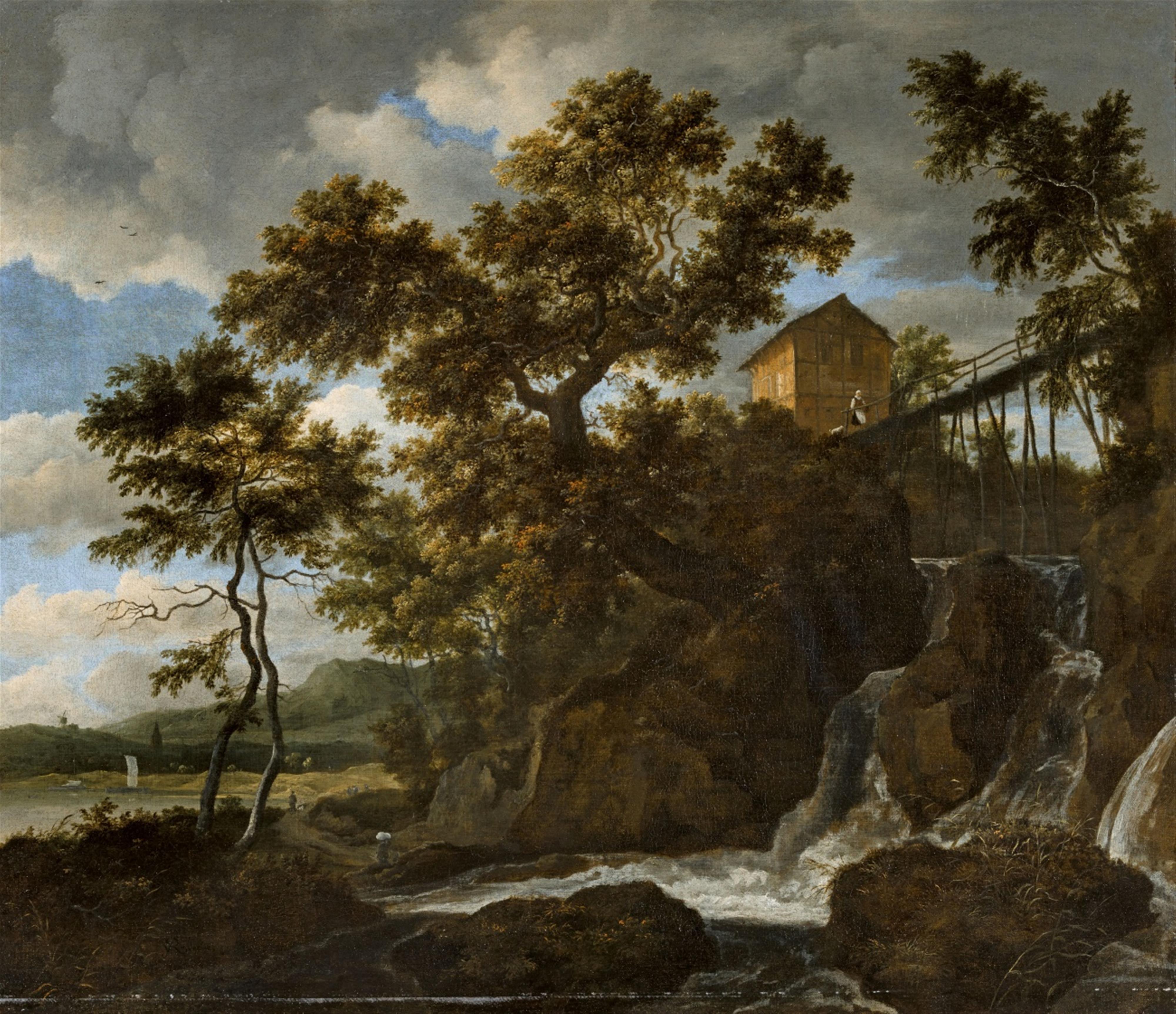Jacob van Ruisdael
Landscape with a Waterfall, Cottage, and Bridge
Oil on canvas (relined). 64.7 x 75 cm.
Signed lower left: Ruisdael.
A fine work by the pre-eminent landscape painter Jacob van Ruisdael, which can be tentatively dated to ca. 1660-1670.
This splendid view depicts a lofty hill, atop which is built a rustic half-timbered house. To the right, large volumes of water flow from a precipitous cliff, colliding down, rushing and foaming onto a rocky bank in the foreground of the painting. In centre, an imposing beech tree grows from the side of the hill; so aptly painted, its foliage signals the coming of autumn. Amidst this rugged wilderness stands a delicate footbridge high above the waterfall, where a farm maid crosses with her dog. The fragility of the structure stands in contrast to the rushing torrent below and Ruisdael has conjured a sense of vertigo through the effect. The tension of these elements is characteristic to his œuvre - the leitmotiv of nature's drama set against tranquil pastoral life has defined Jacob van Ruisdael's work. To the left the eye discovers a more peaceful setting. Looking through an opening, a quiet valley appears. A path with travellers meanders to a calm lake, with moored sailing boats. Further beyond in the distance, a windmill stands against the sky in the receding hills. The overall effect on the Dutch 17th century viewer was of a foreign and grandiose wilderness, painted with singular delicacy.
The accuracy of detail and lifelike nature of the landscape convinces the viewer it is based on intense, first-hand study of the elements. It is astonishing when we realise that Ruisdael did not know such scenes from direct observation. Thorough research of his life and travels suggests that he never saw these kinds of Scandinavian landscapes and that his vision is based on art, not nature. The rustic house, a typical accent of his paintings which appears frequently in his works, is drawn from observation of buildings in the vicinity of Bentheim in the early 1650s. However, rushing torrents came to his work later and were initially inspired by the works of his friend, the Alkmaar artist Allart van Everdingen (1621-1675). Following his trip to the Southern coasts of Norway and the area of Göteborg in Sweden in 1644, Everdingen is considered to have innovated the style. Despite these early influences, it was not until the late 1650s, when Ruisdael moved to Amsterdam, that he started producing these Norwegian views himself. He would quickly surpass all competition in this field, making it a major subject of his œuvre and finding lasting success in the exceptional appeal of his Scandinavian waterfalls.
It is interesting to note Houbraken's suggestion of a play on the subject in the artist's name: “Ruis dael” - “noisy valley”. Here may lie a clue to the master's identification to his work. He tells us Ruisdael: “...painted both native and foreign landscapes, particularly those in which water is to be seen dashing from one rock to another, finally to end with a noise [geruis] (as his name seems to intimate) down through the valley [dalen]. And he could depict water splashing and foaming, as it dashed upon the rocks so naturally clear and trans-parent, that it appears to be real water” (cf. Slive, op. cit., p. 154 and Houbraken, op. cit., p. 65-66).
We are grateful to Ellis Dullaart and Fred Meijer for confirming the present painting as an authentic work by Jacob van Ruisdael.
Provenance
In an English private collection for four generations. - Verso Christie's no !92 V. The number was consigned in 1885, but apparently never came up for auction.
Literature
S. Slive, Jacob van Ruisdael: A complete catalogue of his paintings, drawings and etchings, Yale University Press: New Haven & London, 2001. - A. Houbraken, De groote schouburgh der Nederlantsche konstschilders en schilderessen, 3 vols. Amsterdam, 1718-1721.

